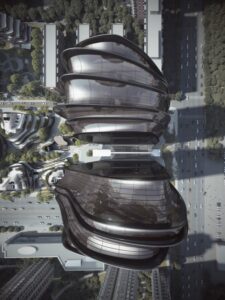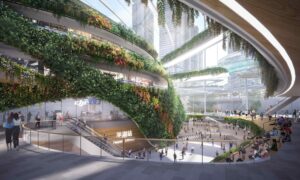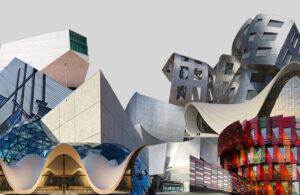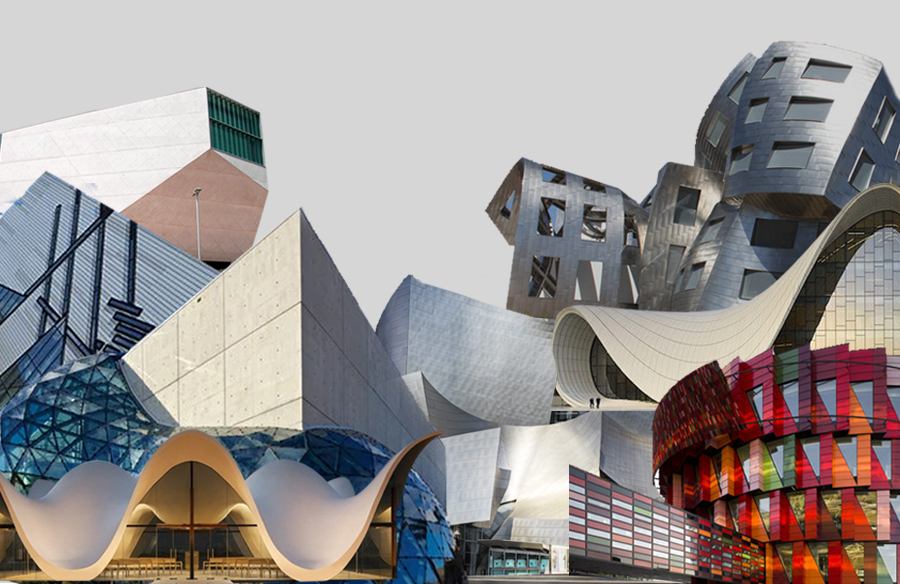Recent and Futuristic Trends in Contemporary Architecture
“When we build, let us think that we build forever.”
-John Ruskin
Contemporary architecture is a dynamic field that continually evolves to reflect changing societal, technological, and environmental influences. Recent years have witnessed remarkable innovations in architecture, paving the way for exciting future trends. In our previous post, we talked about the concept of contemporary architecture, and some existing examples of the same. To take it forward, we explore here some recent trends and anticipate future developments in contemporary architecture.

Recent trends in contemporary architecture
- Sustainability and green design
Sustainability is in the forefront of contemporary architecture. Architects are increasingly incorporating green design principles to create environment-friendly buildings. For example, the Bosco Verticale in Milan, designed by Stefano Boerie. This is a pair of residential towers covered in lush vegetation. It reduces the building’s environmental impact besides enhancing the aesthetic appeal. GAIL Jubilee Tower in NOIDA, designed by Nirman Consultants Pvt Ltd is another example that strives to achieve energy efficiency along with zero-discharge water facility.

- Adaptive Reuse
The adaptive reuse of the existing structures is gaining momentum. Architects are transforming old factories, warehouses, and even religious buildings into modern spaces. The Tate Modern in London, designed by Herzog and de Mueron, is a prime example of this trend. This was converted from a disused power station into a world-renowned contemporary art museum.
- Minimalism
Minimalism has been a dominant aesthetic trend in the recent years. Architects are opting for clean lines, simple forms, and a reduction in unnecessary ornamentation. The Farnsworth House by Ludwig Mies van der Rohe is a quintessential example of minimalism, with its glass walls and open spaces that bring the outside in.
- Smart buildings
Advancements in technology have given rise to smart buildings, which integrate automation, energy efficiency, and connectivity. The Edge in Amsterdam, designed by PLP Architecture, uses sensors and data analysis to optimize energy consumption and enhance the comfort of its occupants.
- Mix-use developments
Contemporary architecture is embracing mix-use developments that combine residential, commercial, and recreational spaces in a single complex. Hudson Yards in New York, designed by various architects, is a massive mix-use development that includes residential towers, office spaces, shops, and green spaces..
Expected futuristic trends in contemporary architecture

- Biophilic design
Biophilic design, which focuses on incorporating nature into the built environment, is expected to grow in importance. Architects will use more natural materials, green spaces, and natural light to improve the overall well-being of the occupants. The Future Cite in Lyon, designed by Suo Fujimoto, is an upcoming project that emphasizes biophilic principles.
- Resilient and disaster-resistant architecture
As the world grapples with climate change, architects will play a vital role in designing structures that can withstand natural disasters and extreme weather events. Examples include floating and amphibious architecture, like the Lilypad concept designed by Vincent Callebaut, which envisions floating sustainable cities.
- 3D printing and prefabrication
Innovations in 3D printing and prefabrication will revolutionize construction methods. This technology allows for faster and more efficient building processes. ICON’s 3D printed homes and Epis Core’s 3D-printed houses are just a glimpse of the potential in this area.
- Inclusivity and Universal Design
Future architecture will place a greater emphasis on inclusivity and universal design to accommodate people of all ages and abilities. The Maggie’s Centers, designed by various architects, offer a model for healthcare architecture that prioritizes inclusivity and patient comfort.
Contemporary architecture is an ever-evolving field that responds to needs and challenges of the times. Recent trends have sen a focus on sustainability, , adaptability, minimalism, and technology integration. The future promises even more exciting developments, including biophilic design, resilience, 3D printing, and inclusivity. As architects continue to push boundaries, we can anticipate that the built environment will become more environmentally conscious, , technologically advanced, and accessible for all, creating better world for future generations.
We will come up with another exciting new topic in our next blog post, don’t miss the fun!
Sources:
https://www.actitime.com › software-for-architects › arch…
https://www.thedecorativesurfaces.com › five-key-tren…
https://www.livehome3d.com › useful-articles › 10-tre…
https://www.re-thinkingthefuture.com › a3022-10-ne…
https://www.arch2o.com › 9-architectural-trends-for-2…

